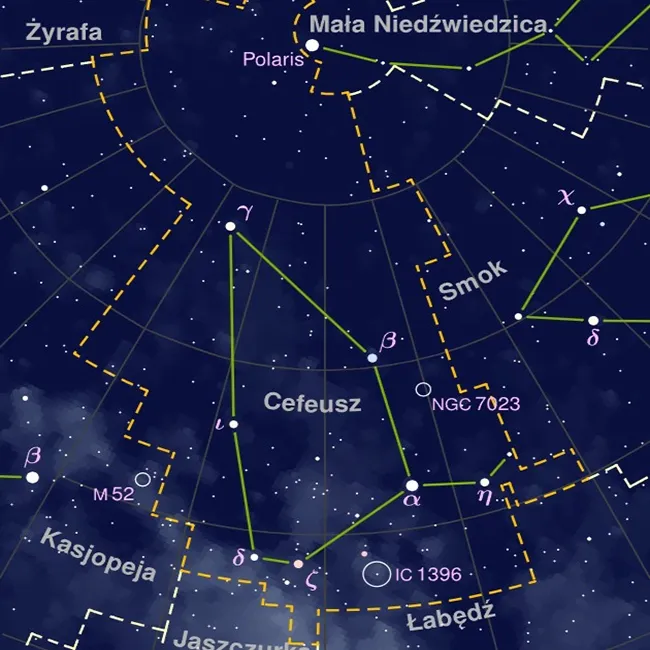
Cepheus is a northern constellation named after the mythological King Cepheus of Aethiopia. It is one of the 48 constellations listed by the Greek astronomer Ptolemy in the 2nd century and remains one of the 88 modern constellations recognized today. Though not as prominent as nearby constellations like Cassiopeia, Cepheus is still an important part of the night sky, especially for those interested in ancient mythology and celestial navigation.
Key Features
Cepheus is shaped roughly like a house with a pointed roof or a simple crown, with its main stars forming a pentagon-like pattern. It covers an area of 588 square degrees, making it the 27th largest constellation in the sky. Although it doesn't contain any particularly bright stars, its distinctive shape makes it easier to spot in the night sky.
Mythology
In Greek mythology, Cepheus was the king of Aethiopia, husband of Cassiopeia, and father of Andromeda. According to the myth, Cepheus and Cassiopeia angered the gods by boasting that their daughter, Andromeda, was more beautiful than the Nereids, sea nymphs. To appease the gods, they chained Andromeda to a rock as a sacrifice to the sea monster Cetus. However, she was saved by the hero Perseus, who later married her. The entire family was immortalized in the stars, with Cepheus being one of the key figures in this celestial drama.
Notable Stars
- Alderamin (Alpha Cephei): The brightest star in Cepheus, Alderamin is a white star located about 49 light-years from Earth. It is a rapidly rotating star and will become the North Star in approximately 7,500 years due to the precession of the equinoxes.
- Beta Cephei: A prototype of a class of variable stars known as Beta Cephei variables. These stars exhibit slight changes in brightness due to pulsations on their surfaces.
- Gamma Cephei (Errai): A binary star system located about 45 light-years away. It is noteworthy because one of its stars will also become the North Star in about 1,000 years.
Visibility
Cepheus is a circumpolar constellation, meaning it never sets below the horizon for observers in the Northern Hemisphere. It is visible throughout the year but is best observed in late summer and autumn. Its position near the North Celestial Pole ensures that it is always visible, though its exact placement in the sky will change depending on the time of year.
Tips for Observing
- Use Nearby Constellations: Cepheus is located near several more recognizable constellations, including Cassiopeia, Draco, and Ursa Minor. Cassiopeia, with its distinctive "W" shape, can be used as a guide to find Cepheus.
- Dark Skies: While Cepheus can be seen in urban areas, observing it from a location with dark skies will reveal more of its fainter stars and enhance your viewing experience.
- Binoculars or Telescope: To observe some of the fainter stars or deep-sky objects within Cepheus, consider using binoculars or a small telescope. This will allow you to see more detail and better appreciate the constellation’s features.
